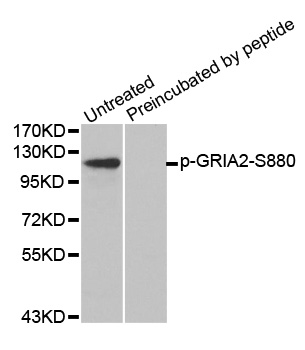Ionotropic Glutamate receptor 2 (GRIA2) Rabbit Polyclonal Antibody
Other products for "GRIA2"
Specifications
| Product Data | |
| Applications | WB |
| Recommended Dilution | WB 1:500 - 1:2000 |
| Reactivities | Human, Mouse, Rat |
| Modifications | Phospho-specific |
| Host | Rabbit |
| Isotype | IgG |
| Clonality | Polyclonal |
| Immunogen | A phospho specific peptide corresponding to residues surrounding S880 of human GRIA2 |
| Formulation | Store at -20°C (regular) and -80°C (long term). Avoid freeze / thaw cycles. Buffer: PBS with 0.02% sodium azide, 50% glycerol, pH7.3. |
| Concentration | lot specific |
| Purification | Affinity purification |
| Conjugation | Unconjugated |
| Storage | Store at -20°C as received. |
| Stability | Stable for 12 months from date of receipt. |
| Predicted Protein Size | 883 |
| Gene Name | glutamate ionotropic receptor AMPA type subunit 2 |
| Database Link | |
| Background | Glutamate receptors are the predominant excitatory neurotransmitter receptors in the mammalian brain and are activated in a variety of normal neurophysiologic processes. This gene product belongs to a family of glutamate receptors that are sensitive to alpha-amino-3-hydroxy-5-methyl-4-isoxazole propionate (AMPA), and function as ligand-activated cation channels. These channels are assembled from 4 related subunits, GRIA1-4. The subunit encoded by this gene (GRIA2) is subject to RNA editing (CAG->CGG; Q->R) within the second transmembrane domain, which is thought to render the channel impermeable to Ca(2+). Human and animal studies suggest that pre-mRNA editing is essential for brain function, and defective GRIA2 RNA editing at the Q/R site may be relevant to amyotrophic lateral sclerosis (ALS) etiology. Alternative splicing, resulting in transcript variants encoding different isoforms, (including the flip and flop isoforms that vary in their signal transduction properties), has been noted for this gene. |
| Synonyms | GluA2; GluR-K2; GLUR2; GLURB; HBGR2 |
| Reference Data | |
| Protein Families | Druggable Genome, Ion Channels: Glutamate Receptors, Transmembrane |
| Protein Pathways | Amyotrophic lateral sclerosis (ALS), Long-term depression, Long-term potentiation, Neuroactive ligand-receptor interaction |
Documents
| Product Manuals |
| FAQs |
{0} Product Review(s)
0 Product Review(s)
Submit review
Be the first one to submit a review
Product Citations
*Delivery time may vary from web posted schedule. Occasional delays may occur due to unforeseen
complexities in the preparation of your product. International customers may expect an additional 1-2 weeks
in shipping.






























































































































































































































































 Germany
Germany
 Japan
Japan
 United Kingdom
United Kingdom
 China
China



